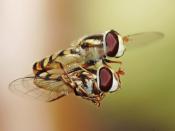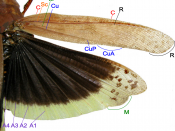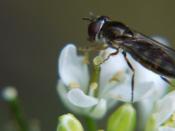Movement - Having 6 legs, insects move on alternating sets of tripods. The three black legs are those that are touching the ground; the yellow legs are being lifted and moved forward.
Aquatic motion - Surface walkers, because of their small size, are able to walk on the water surface tension. They may use hairs to increase their surface area or wax to make themselves more water repellent. Others use fin shaped wings or legs to propel themselves through the water.
Other insects have acquired the ability of flight. Some use the primitive way of directly attaching the flying muscle to the bone, and some use the more efficient way of indirectly attaching their flying muscles to the bone.
Except for a few primitive insect groups, all insects are winged or are secondarily wingless (wings lost from groups whose ancestors were winged).
Insect veins are apparent on most insect wings. Veins serve two purposes. To inflate the wings of insects emerging from pupae. To provide rigidity and structural support to the wing. If an insect did not have veins in its wings, it couldn't fly.
Respiration - a simple passive diffusion of O2 or CO2 through the air-filled tracheal system could allow the insect to perform all of it's natural functions. Insects breath like all insects through openings in their body called spiracles. These openings lead the oxygen through a complex system of tubes which are called trachea. The trachea run through the whole insect body. At certain points on the insect's body, main tracheae connect to the outside air through openings in the cuticle. These slits (called spiracles) are relatively large and are opened and closed according to need. Air can be pumped in by expanding the body. The amount of inspired oxygen is limited with such system.


